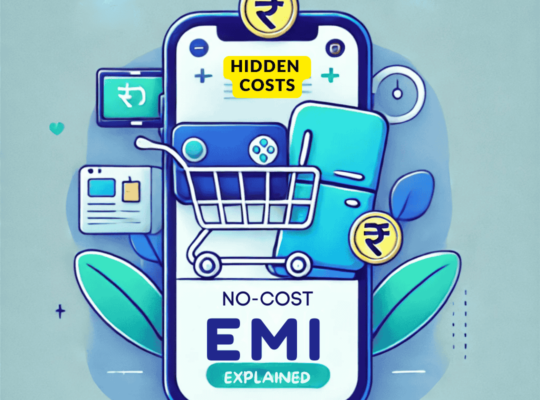
When a baby is born, it marks not just a joyful beginning but also the ideal time to start planning for their future. A child’s financial journey should begin early, even before they take their first steps or say their first words. Despite the added expenses of raising a newborn, this is a crucial moment for parents to set financial goals that ensure long-term security. Whether it’s saving for higher education, planning for marriage expenses, or building a financial safety net, starting early can make a significant difference in shaping a strong financial foundation.
In this blogpost, we will discuss various ways in which parents can begin investing for their newborn immediately after birth. Whether you choose to invest through your own accounts or open a separate account in your child’s name, the idea is to build a strong financial foundation that your child can benefit from when they turn 18.
Table of Contents
Why Begin your Child’s Financial Journey Early?
Starting early is one of the best strategies for long-term financial growth. When you invest money at a very young age, even small amounts can grow significantly over time thanks to the power of compounding. This means that every rupee you save today has the potential to multiply and serve important future needs such as education or marriage. By making these investments early on, you ensure that the funds grow gradually, offering your child financial security as they grow older.
Investing from the cradle also means that you can gradually introduce your child to the concept of money management and financial planning. When they are older, having an established investment portfolio can serve as an excellent introduction to personal finance, making them more responsible and financially aware.
Gathering the Essential Documents
Before you can start investing for your newborn, you must take care of some basic paperwork. Financial institutions require proper documentation, even for infants, so that they can comply with know-your-customer (KYC) norms.
Birth Certificate
The first step is obtaining your baby’s birth certificate. This vital document will be used to apply for other identification proofs like an Aadhaar card or a PAN card.
Aadhaar Enrollment
Enrolling your newborn for an Aadhaar card is straightforward. You can visit any permanent Aadhaar center, and during the process, your baby’s details will be added along with some of your information, such as your phone number, email address, and residential address. A photograph of the baby is taken at enrollment, but biometric data (like fingerprints or iris scans) is captured only after the child turns five.
PAN Card Application
A PAN card is also essential for financial transactions. To apply for a PAN card, fill out Form 49A and submit it along with supporting documents that verify your baby’s identity, age, and address. The National Securities Depository Ltd (NSDL) in Pune handles these applications. Getting these documents in order early on ensures that your child will be ready to participate in financial transactions when needed.
Opening a Bank Account for Your Child

Once you have the necessary documents, the next step is to open a bank account for your newborn. Although you may use your own bank account initially, opening a dedicated bank account in your child’s name is a wise decision. This kind of account, often called a “minor bank account,” is typically a joint account in which you, as a parent or legal guardian, co-own the account until your child turns 18.
A minor bank account can serve several purposes:
- Depositing Savings and Gifts: It can be used to deposit money regularly or hold cash gifts from relatives.
- Managing Investments: Investments meant for your child’s future should ideally be kept separate from your own funds.
Opening a minor bank account is simple. You need to provide your baby’s birth certificate, along with your own PAN and Aadhaar for identity and address verification. In cases where you already have an account with the bank, some of these documents might not be necessary. Note that banks have different policies; for instance, the minimum average balance (MAB) requirement can vary anywhere from Rs. 2,500 to Rs. 10,000.
Investing in Mutual Funds
One of the most popular ways to invest for long-term goals is through mutual funds. These funds allow you to pool money into a diversified portfolio, which can then grow over time. You can invest in a mutual fund account that is registered in your child’s name using the funds from the minor bank account.
How to Get Started:
- Documentation: To open a mutual fund account, you will need to provide your baby’s birth certificate to confirm age and establish your relationship as the parent or legal guardian. A cancelled cheque from the child’s bank account (or sometimes your own) may also be required.
- Systematic Investment Plans (SIPs): Many parents opt for systematic investment plans. With SIPs, you invest a fixed sum every month. For example, one parent might choose to invest Rs. 10,000 per month in equity funds, which are known for their long-term growth potential.
Equity funds, although subject to short-term market fluctuations, tend to yield good returns over extended periods. The idea is that market volatility smooths out over the long run. To illustrate this point, imagine a monthly SIP of Rs. 5,000 invested in an index like the Nifty 50. With an assumed annual return of about 12.4%—based on historical data over the past 30 years—this investment could grow to nearly Rs. 37.3 lakhs by the time your child reaches 18. This example highlights the benefit of starting early and remaining consistent.
Government-Backed Savings Schemes
For parents looking for secure, government-supported options, there are a couple of attractive schemes available.
Sukanya Samriddhi Yojana (SSY)
This scheme is designed specifically for parents of a girl child. Here’s what you need to know about SSY:
- Eligibility: You can open an SSY account any time after the birth of your daughter until she reaches 10 years old.
- Investment Requirements: The account can be started with a minimum deposit of Rs. 250, and you can deposit up to Rs. 1.5 lakh in a financial year.
- Interest Rate: The government recently increased the interest rate on SSY deposits to 8.2%.
- Account Details: An SSY account can be opened at most banks or even post offices. You will need to submit your daughter’s birth certificate along with your own KYC documents (like PAN and Aadhaar). Contributions to the account can be made for up to 15 years, and the account matures 21 years from the date of opening. (If your daughter marries before she turns 21, the account can be closed.)
I have written a detail article on Sukanya Samriddhi Yojana (SSY) in my blog page. You can read through that as well for a detailed view of this investment product and then make an informed decision for your daughter’s financial future.
Public Provident Fund (PPF)

Another excellent long-term savings option is the PPF account:
- Setting Up: The documentation required is similar to that for the SSY account.
- Initial and Annual Contributions: You only need an initial deposit of Rs. 100 to start, and annual contributions can range between Rs. 500 and Rs. 1.5 lakh.
- Interest Rate and Benefits: The current interest rate for PPF stands at about 7.1%. One major benefit of opening a PPF account early is that by the time your child turns 18, the mandatory lock-in period of 15 years might be over. This gives your child the choice of either continuing with the account or withdrawing the funds.
Both SSY and PPF accounts fall under the “Exempt-Exempt-Exempt” (EEE) tax category. This means that the money you deposit, the interest earned, and the final maturity amount are all tax-free. However, remember that if you redeem any investment before your child reaches 18, any capital gains might be taxed in your name, and the interest or dividends could be added to your taxable income.
Investing in Digital Gold
Gold has always been a favoured investment in India, and many newborns are gifted gold coins or bars by well-wishers. However, storing physical gold can be inconvenient and risky. Today, many parents prefer to invest in digital gold, which offers several benefits over traditional physical gold.
Options for Digital Gold:
- Sovereign Gold Bonds (SGB): These bonds not only invest in gold but also pay interest.
- Gold ETFs: These are funds that invest in gold and can be traded like stocks.
- Gold mutual funds: These are investment funds that primarily focus on gold or gold-related assets. Investors buy shares or units of these funds, which are managed by professional fund managers.
Digital gold investments guarantee purity and eliminate the hassles of storing physical gold. Moreover, they avoid additional costs like making charges, storage fees, and insurance. You can easily purchase digital gold through mobile apps or online platforms, making it a secure and flexible option.
Once purchased, you can transfer these digital gold units, be they SGBs or Gold ETF units, into your child’s demat account. A demat account holds securities in an electronic form and is managed by you until your child turns 18. Although a minor’s demat account cannot be used to buy shares directly, you can transfer shares or digital gold to it as a gift. Opening such an account requires a stockbroker, and you will need your child’s PAN and Aadhaar for verification.
Keeping Your Child’s Investments Separate
It’s a good idea to keep your child’s investments separate from your own. By doing so, you ensure that the money set aside for your child is used only for their future needs. This separation is especially important in India, where cultural expectations often mean that parents shoulder the responsibility for funding education, marriage, and other significant expenses.
Maintaining separate accounts, a dedicated bank account, a separate demat account, and an independent mutual fund portfolio, helps you “ring-fence” the funds. This approach makes it easier for your child to access and manage their own investments once they reach 18. Until then, you will be responsible for managing these funds and ensuring they grow as planned.
Tips for a Successful Investment Journey
Embarking on the journey of investing for your child might seem daunting at first, but a few practical tips can help guide you along the way:
- Set Clear Goals: Before you begin, decide what you’re saving for. Whether it’s for college fees, a wedding, or starting a business, having clear objectives will help you choose the right investment options.
- Start Small, but Start Early: Even small monthly contributions can add up over time. The key is to begin as soon as possible so that your money has time to compound.
- Be Consistent: Regular investments, whether monthly or yearly, are crucial. Stick to your investment schedule, no matter how modest the amount.
- Educate Yourself: Learn about different investment avenues. Read articles, watch webinars, or speak with a financial advisor to find the best strategies tailored to your child’s future.
- Review and Adjust: Life is full of changes. Revisit your investments periodically and adjust your strategy to match your evolving financial goals.
- Diversify: Don’t rely on just one type of investment. Spread your investments across mutual funds, government schemes like SSY and PPF, and even digital gold to balance risk.
- Plan for Emergencies: While focusing on long-term goals, don’t forget to maintain an emergency fund. This separate reserve will help you cover unexpected expenses without affecting your child’s dedicated savings.
Following these guidelines can help you build a robust financial base for your child and ensure you’re prepared for both opportunities and challenges.
Health Insurance: A Vital Component

While building an investment portfolio is crucial, don’t overlook the importance of health insurance. Adding your newborn to your family’s health insurance plan is as essential as saving for their future. In many cases, financial experts recommend that you notify your insurer as soon as your baby is born so they can be included in the policy.
Options to Consider:
- Family Floater Plans: If you already have a family floater health insurance policy, contact your insurer to add your newborn after the mandatory waiting period (usually 90 days).
- Individual to Family Conversion: If you have individual health policies, you might consider converting them into a family floater plan to cover all family members.
- Adequate Coverage: Ensure that your overall health insurance coverage is sufficient not only for your child but for your entire family. Inadequate coverage might force you to dip into the funds you’ve set aside for your child in the event of a health emergency.
Proper health insurance acts as a safety net, protecting both your investment funds and your family’s well-being.
Gifted Investments: A Thoughtful Addition
Even though minors cannot independently purchase shares, ETFs, or other securities, they can receive them as gifts from family members or relatives. Gifting investments such as shares or ETFs is a creative way to introduce your child to the world of investing. Such gifts can serve as an educational tool, helping your child understand how the market works and the importance of long-term financial planning.
Before you gift investments, it’s wise to understand the tax implications. In many cases, the tax liability for capital gains on such investments might fall on the parent if the gift is redeemed before the child reaches 18. Therefore, planning and proper documentation are essential to ensure that the transfer of these assets is both smooth and tax-efficient.
Check out my other article on Gifting Shares & ETFs to your loved ones, wherein I have we delved into the benefits of gifting shares and ETFs, how they serve as an introduction to investing, and the tax implications one should be aware of while gifting.
Final Thoughts: Securing a Bright Future
Starting your child’s investment journey early is one of the most thoughtful decisions you can make as a parent. Whether it’s by opening dedicated bank accounts, investing in mutual funds, taking advantage of government schemes like SSY and PPF, or opting for digital gold, every small step counts. The money you invest today has the potential to grow over the years and provide a significant financial cushion for your child when they step into adulthood.
This financial head start not only supports major milestones like education and marriage but also instils the values of financial discipline and smart investing. As your child matures, the investments you set up today can serve as a valuable learning tool and a stepping stone to their own financial independence.
Remember, even if you start small, the magic of compounding will help your investments grow over the years. With patience, regular contributions, and a diversified portfolio, you can ensure that your child’s financial future is secure and bright.
The journey may seem overwhelming at first, but every step you take now lays the groundwork for a financially stable future. Embrace the process, educate yourself, and adjust your strategies as needed. Your commitment today will be the key to unlocking a prosperous tomorrow for your little one.
Do Follow me on Linkedin and Quora for more insightful posts on personal finance, money management, debt management, investments and much more.





